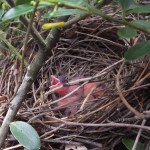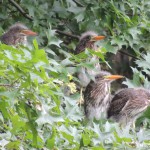
Baby cardinals, so hard to find, have a weird red tint to their bodies. After years of looking I finally found a nest. The babies left before I thought they could make it. I’ll never know if they did.
Keep reading The Elusive Cardinal Nest
 Baby cardinals, so hard to find, have a weird red tint to their bodies. After years of looking I finally found a nest. The babies left before I thought they could make it. I’ll never know if they did. Keep reading The Elusive Cardinal Nest  Birders harass dog people in Prospect Park saying they disturb ground-nesting birds. But only six species nest on the ground here, none exclusively. Some aren’t even in the park in the summer. Keep reading Dogs Don’t Eat Warblers–in Prospect Park or Anywhere  Several pairs of green herons are building nests or raising young in what’s becoming a heron co-op near the Lullwater in Prospect Park. Keep reading Green heron co-op forming in Prospect Park  The latest animal research seems to prove that animals are sexually and morally freaky in ways we never imagined. This book turns biology into fun sideshows. Keep reading Zombie Birds shows us we still have a lot to learn about animals  Roost of hundreds or thousands of Double-crested Cormorants, Phalacrocorax auritus, on Cedar Pond, near Route 6’s Orleans rotary. One of the most striking wildlife sites on Cape Cod is one locals hate: a spectacular cormorant roost on electric wires over Cedar Pond near Orleans. You pass the roost just south of the Orleans rotary on Route 6, Cape Cod’s main highway, and it turns your head. Cormorants are big, loud and chatty. And the roost just keeps on going as you drive. Wayne Petersen, who manages the important bird areas for Mass Audubon, says that neighbors had tried to get rid of it, but apparently gave up. “You can imagine the chloroform count in that pond,” he says. The problem isn’t the sight or sound, but the smell of the guano. Back in 1999, residents got a permit to scare the migratory birds off by firing pyrotechnics, the Cape Cod Times says. They were still missing in 2004, according to Bird Watchers General Store, which says the stink from the pond was “so vile that even a black lab wouldn’t roll in it.” If you think you’re seeing more cormorants now than you did growing up, you’re right. This Cape Cod roost is one of many that have popped up along the coast–with similar results. People wiped out the birds in the 1800s. Fishermen still view them as competition. And some people just find their stooped neck sunning kinda creepy. But Mass Audubon says the birds, absent as recently Keep reading Enormous cormorant roost comes back on Cape Cod  Biologists use brain scans (and entertaining experiments and anecdotes) to show that crows, ravens and other corvids think like people. Keep reading Gifts of the Crow: brain scan proof these birds are devious, silly and smart  For about $3,700 you can buy a tame fox puppy from Russia. You’d support important research on domestication and save the pup from a fur farm. Keep reading Buy your own pet fox puppy–and help save an important experiment  Smiling SeaWorld Dolphin,Courtesy of Blaine Hansel. Think that smiling dolphin is happy to see you? Think again. If you’re looking at brochures for Florida’s hundreds of dolphin tours, you and the dolphin may be better off if don’t fall for the smiley dolphin tour ads. That familiar pose is really a dolphin begging for food–something wild dolphins shouldn’t do, says Jessica R. Powell, biologist from the National Marine Fisheries Service. “It’s a very unnatural behavior,” says Powell. “You never see a wild dolphin doing this unless it’s fed or conditioned to people. It’s actually an indication of a number of problems” with how people are treating that dolphin.That’s why the Fisheries Service voluntary guidelines for tours, Dolphin Smart, bans the begging dolphin grin pictures in ads–along with anything else that gives you the idea you’re going to be hanging out with some wild dolphins that will be thrilled to make your acquaintance. The program’s main thrust is about not disturbing the dolphins. Operators go through training, learning keep respectful 50 yards from dolphins, learn signs that they’re getting annoyed with you (they may “chuff”–a kind of angry dolphin huff–for example) and put their engines in neutral when a dolphin approaches. Plus, they have to teach the public about dolphins. But teaching tourists dolphin etiquitte is a hard in market where hundreds of tours compete for tourists. Powell recently counted 107 outfits doing tours just on the west coast of Florida from Tampa south. For 66, dolphins are their primary Keep reading Avoid the Smiling Dolphin |
|
|
Copyright © 2024 AnimalTourism News - All Rights Reserved |
|
Recent Comments